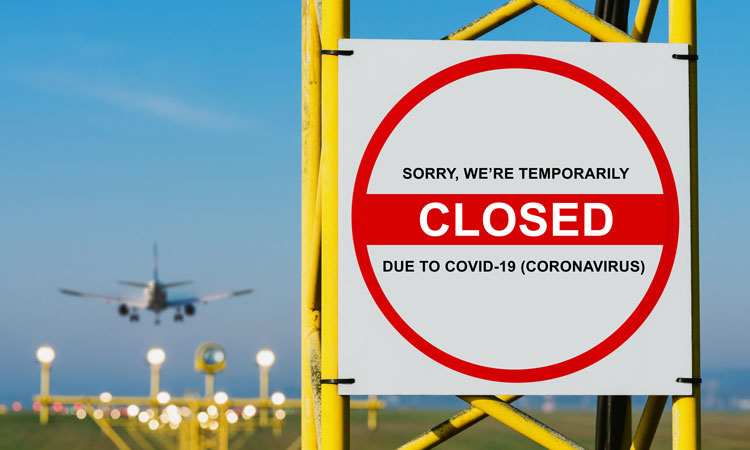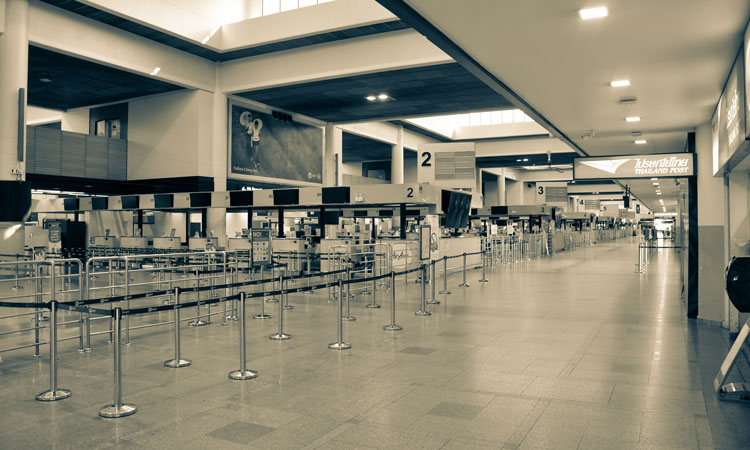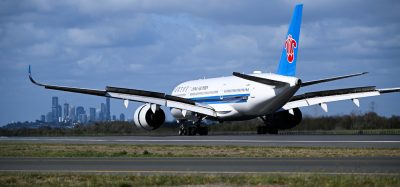To recover from COVID-19, airports need a bailout too
- Like
- Digg
- Del
- Tumblr
- VKontakte
- Buffer
- Love This
- Odnoklassniki
- Meneame
- Blogger
- Amazon
- Yahoo Mail
- Gmail
- AOL
- Newsvine
- HackerNews
- Evernote
- MySpace
- Mail.ru
- Viadeo
- Line
- Comments
- Yummly
- SMS
- Viber
- Telegram
- Subscribe
- Skype
- Facebook Messenger
- Kakao
- LiveJournal
- Yammer
- Edgar
- Fintel
- Mix
- Instapaper
- Copy Link
Posted: 20 April 2020 | Ilia Lioutov - ACI World | No comments yet
In regard to government aid during the COVID-19 crisis, Ilia Lioutov – Senior Manager of Economics and Policy at ACI World, says it would be very short-sighted to support only one actor in aviation. Airports have an equal role to play in the prospective recovery.


COVID-19 has seriously disrupted aviation, both airports and airlines, to say the least. As most countries introduced stringent travel advisories or outright bans in order to restrict the spread of the virus, air transport demand fell off a cliff.
As a result, airline operations came to a standstill posting reductions of almost a triple-digit magnitude. Some players like Austrian Airlines or Brussels Airlines decided to suspend all operations early in the game. Others like Air Canada or Lufthansa retained a limited number of domestic flights, and international operations one can count on the fingers of one hand.
Even though airlines are indeed the largest single component of the ecosystem, at least from a turnover perspective, they are by no means sufficient to ensure that the industry is able to recover after the COVID-19 shock
The combination of trip cancellations and country-specific restrictions on international flights quickly amounted to a cost of roughly $1 trillion (US$), according to the industry estimates.
The crisis produced a whole sequence of events that would have been unimaginable under normal circumstances. Even the ‘big guys’ had no other way but to prematurely retire the ‘big birds’ in a desperate attempt to scrape together whatever liquidity they were left with before the emergency brake.
That is to say, a number of large airlines had to retire forever the four-engine passenger widebodies, namely Airbus A340, Airbus A380 and Boeing B747. Even the Great Recession of 2008 coupled with oil prices in summer 2018 as high as US$165 per barrel could not achieve it – the best testament to truly remarkable times for commercial aviation.
As such, it is not surprising that McKinsey & Company in its COVID-19 briefing materials pointed to the fact that among 30 major industries, the two most severely affected by the health outbreak are commercial aerospace, and air and travel, with an estimated reduction of about 50 per cent in 2020.
Airlines and government behaviours
As it became clear that airlines – small or big, private or public – had enough liquidity to sustain for two weeks to two months, they naturally turned to national governments for help.
Being major employers, economic enablers and occasionally a source of national pride, airlines felt entitled to benefit from state coffers. This is especially true for countries implementing extensive fiscal and monetary stimuli.
The philosophy behind such thinking is understandable: If the government can provide assistance without serious long-term economic ramification, it should do so and to the benefit of all sectors, not only banks and a few others.


Airports and airlines are both feeling the impacts of diminishing air travel demand
The airline industry, however, has a long history of volatility and financial difficulties.
Rigas Doganis defines airlines as an “inherently unstable industry”, mentioning that four to five years of global losses are typically followed by five to six years of profits. When the market is buoyant, you are incentivised to play it bold, otherwise you will lose your market share and the right momentum.
Now we are in a totally different reality, where all new aircraft, business class configurations, convenient schedules and competitive airfares became attributes of a good life of the past.
What matters the most these days is whether you are able to sustain yourself with a reasonable damage until the industry starts to slowly pick up, without falling bankrupt.
Scarlett O’Hara – the ‘Gone with the Wind’ heroine with her steely optimism – is a perfect tough-times model. She survived everything: The Civil War, fire, poverty, hunger, thieving Yankee deserters, carpetbaggers, weak-willed husbands and lovers, a feeble-minded father, disapproving neighbours, spiteful relatives and the maddeningly elusive Rhett Butler.
Airlines weren’t nearly as strong as O’Hara even before the global pandemic crisis, so we hope that government assistance will help airlines to continue their operations once the pandemic is under control, as the opposite would be tragic.
Airports – the elephant in the room
Bailing out airlines is inevitable. It is not only because of the ‘too big to fail’ philosophy, but because of the objective role air connectivity plays today in the global economy.
In simple terms, there is no choice but to get airlines back on track and re-establish the familiar flights grid we are accustomed to see. No doubt we need airlines to be back.
But it will very short-sighted to pursue this selective, if not discriminatory, approach of supporting just one actor in aviation. Even though airlines are indeed the largest single component of the ecosystem, at least from a turnover perspective, they are by no means sufficient to ensure that the industry is able to recover after the COVID-19 shock.
Aviation is characterised by a high degree of interdependency of all players upon each other. Airports have an equal role to play in the prospective recovery. Imagine, for instance, that airports are not able to staff aircraft rescue and fire-fighting (ARFF) services. In such hypothetical scenario, airlines will not be able to land nor take off aircraft from the ground, as scheduled passenger flights can be operated only if firefighters and equipment on location are ready for duty.
As such, pumping billions of dollars into airlines will not provide a balanced recovery. Imagine if airports are not able to cover the typical operating expenses – cost of insourced staff and contracted services, utilities, supplies, insurance and so on. Airports are not shopping malls with a couple of runways attached, they are sophisticated facilities and businesses in their own right and significant commercial players.
Their business processes are equally dependent on liquidity and cost management, so eliminating airport charges is a utopian idea that will not get aviation anywhere.
Both airlines and airports are equally dependent on the end-users of air transport – passengers and freight forwarders. As such, both players should have a strong motivation to help all parts of the sector to weather the crisis and path the best way to recovery. The prospective recovery should be a collective team effort, rather than a single play.
Stay up to date with the latest news, insights and analysis on how the COVID-19 pandemic is affecting aviation, and what the industry is doing in regard to recovery planning.
What governments can do for airports
In a context where half of traffic and airport revenues are wiped off from airports’ accounts, state aid is a necessary measure to ensure airports, and hence aviation as a whole, survives COVID-19.
Governments can implement an array of creative solutions to help airports to stay afloat. These can include the following:
- Grants and subsidies
- Secured financing
- Loans at preferential rates
- Deferment of loan repayment contracted with government
- Bank guarantees
- Government guarantee to loans contracted by airports with foreign lending agencies.
These comprehensive financial relief packages will support operating expenses, and mainly wages to airport staff. A thorough financial relief package will also ensure that airport operators can continue to service their overall financial and debt obligations and protect their capacity to borrow and to permit a sustainable recovery in the future.
Grants and subsidies
These are basically, non-recurring and non-refundable money allocated with specific short-term objectives, such as keeping airports open to commercial traffic and maintaining a minimal required level of staffing. Wage subsidies are a particular form of government subsidies and can be effective in retaining airport employees. Grants, on the other hand, can be used by airports to pay the rest of the bills – for the contracted services, maintenance, utilities and so on.
In general, grants and subsidies are the preferred mechanism of state support, especially for smaller airports with smaller capital needs and stronger focus on operating expenses and immediate survival.
Secured financing
This is also known as secured debt or secured loan, and is a process whereby liabilities and general obligations that are collateralised by legal rights to specifically designated assets owned by the borrowing institutions in case of bankruptcy, insolvency, liquidation or resolution. From a narrow and maybe even a cynical point of view, airports are very expensive pieces of real estate on vast land areas. If the airport-borrower defaults, the creditor can take possession of the airport assets used as collateral and may sell it to regain some or all of the amount originally loaned to the borrower. The secured type of financing is very comparable to the more familiar mortgage operations with a repossession mechanism as a safeguard and reassurance for the lending institution.
Loans at preferential rates
Another option of injecting the much-need liquidity into the airport sector can take a form of loans at preferential rates. Such loans imply rates that are lower than commercial banks would normally charge, typically a couple of percentage points below the standard interest rates of commercial banks in the Western hemisphere.
As there is an inherent relationship between risk and return represented by bank interest rates, airports are known for low-risk profiles and backed by their assets: It takes US$70 in fixed assets to process one unit of traffic – one passenger or 100kg of air cargo.
According to the ACI Airport Economics Report, airports are a robust and healthy industry with not only strong measures of profitability – 51 per cent EBITDA, 21 per cent net profit margin and 7.1 per cent ROIC, but also with reassuring measures of liquidity and solvency during normal times – acid-test ratio exceeding one, current ratio at around 1.6, debt-to-EBITDA slightly above four and debt-to-equity of 1.2. Considering the overall state of airport economics, loans at preferential rates can be a sound tool to leverage the airport business for its faster recovery.
Deferment of loan repayments
In those cases where debt service on the existing obligations is impossible or impractical from the financial management perspective, deferment of loan repayments should be considered.
Bank guarantees
As for bank guarantees, such mechanisms can assure lending institutions that the liabilities of an airport debtor will be met in case the debtor fails to settle a debt. Bank guarantees can be either direct or indirect, whereby direct guarantees can be issued directly to the beneficiary airport, while indirect guarantees imply using a second bank, typically a foreign bank with legal representation in the beneficiary’s home country.
Exiting the COVID-19 crisis: Relief and recovery
The measures outlined above are only few conventional mechanisms that governments can deploy to ensure that airports can accommodate airlines and passengers in a safe, secure and sustainable way now, and post COVID-19.
However, every country may consider a different combination of measures targeted towards covering airports costs – both operating and capital expenses, and safeguarding airport revenues.
The prospective recovery of air transport is equally dependent on the survival of not only airlines, but airports as well as everyone else in the aviation value chain. When the ongoing health crisis is over and commercial passenger aircraft takes off, airports should be prepared to process passengers according to the new standards.
There is no doubt that these difficult weeks or months of grounded commercial air services will be used wisely by airport operators to build resilience, and in order to do so, they need to rely on the engagement and active participation of states, regulatory authorities and all the stakeholders of the aviation ecosystem so that the path to recovery is sound, seamless and sustainable.
Biography
Ilia Lioutov is an air transport economist with in-depth expertise in economic and financial performance of airports and is currently a Senior Manager, Economics and Policy at Airports Council International (ACI) World.
Lioutov is instrumental in developing ACI World policies in the domains of economic regulation and aeronautical charges, privatisation and public-private partnerships, capacity development and slot allocation. His core responsibilities include formulating advocacy strategies at national and international level and representing the airport industry interests within political, economic and regulatory institutions.
In addition to advocacy, industry representation and stakeholder management, Lioutov has an extensive analytical background and is a contributor to the flagship ACI publications including the Airport Economics Report, World Airport Traffic Report and the series of policy briefs on various topics including private sector participation, airport networks, economic impact assessments and industry crisis management.
Related topics
Airport crisis management, COVID-19, Economy, Passenger volumes, Regulation and Legislation


















